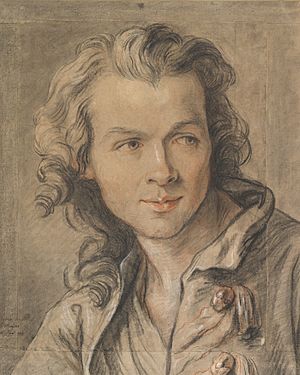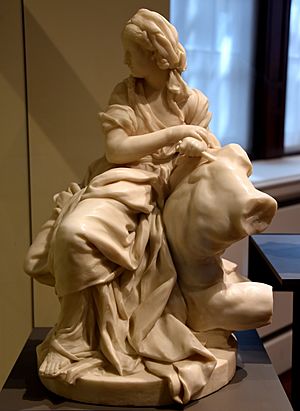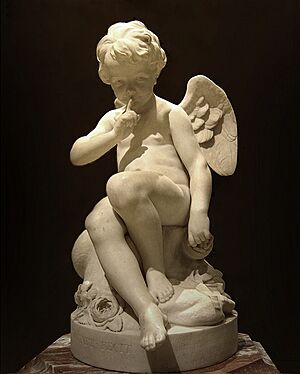Étienne Maurice Falconet facts for kids
Quick facts for kids
Étienne Maurice Falconet
|
|
|---|---|

Étienne Maurice Falconet, in a portrait by Jean-Baptiste Lemoyne (1741)
|
|
| Born | 1 December 1716 |
| Died | 24 January 1791 |
| Nationality | French |
| Known for | Sculpture |
|
Notable work
|
The Bronze Horseman |
| Movement | Baroque, Rococo, Neoclassicism |

Étienne Maurice Falconet (born December 1, 1716 – died January 24, 1791) was a famous French sculptor. He worked in different art styles, including Baroque, Rococo, and Neoclassicism. Falconet is best known for his huge statue of Peter the Great in Russia, called the Bronze Horseman. He also created many small, beautiful statues for the Royal Sèvres Porcelain Manufactory.
Contents
Life and His Amazing Artworks
Early Life and Becoming a Sculptor
Étienne Maurice Falconet was born into a poor family in Paris, France. He started his career as an apprentice to a marble-cutter. In his free time, he loved making small figures from clay and wood. These figures caught the eye of a famous sculptor named Jean-Baptiste Lemoyne. Lemoyne was so impressed that he took Falconet on as his student.
One of Falconet's first big successes was a sculpture of Milo of Croton. This artwork helped him become a member of the Royal Academy of Painting and Sculpture in 1754. This was a very important step for an artist at that time.
Rising to Fame
Falconet became widely known at the Paris Salons, which were big art exhibitions. In 1755 and 1757, he showed his marble sculptures L'Amour (Cupid) and Nymphe descendant au bain (The Bather). The Bather is now a famous piece displayed at the Louvre Museum in Paris.
In 1757, a powerful woman named Madame de Pompadour chose Falconet for an important job. She made him the director of the sculpture workshop at the new Royal Sèvres Porcelain Manufactory. At Sèvres, Falconet brought new ideas to making small, unglazed porcelain figures. These tiny sculptures became very popular across Europe.
The Bronze Horseman
In September 1766, Falconet received a special invitation from Catherine the Great, the Empress of Russia. She asked him to come to St Petersburg to create a huge bronze statue of Peter the Great. This massive artwork is known today as the Bronze Horseman. Falconet worked on this project with his talented student, Marie-Anne Collot. The statue was finished in 1782 and is one of his most famous works.
After his time in Russia, Falconet returned to Paris in 1788. He became an Assistant Rector at the Royal Academy. Sadly, many of his religious artworks were destroyed during the French Revolution. However, his sculptures made for private collectors were often saved.
Falconet's Ideas About Art
Falconet was not just a sculptor; he also loved to learn. He studied Greek and Latin and wrote several essays about art. He even wrote the chapter on "Sculpture" for the famous Encyclopédie by Denis Diderot. Falconet's writings showed his belief that artists create because they feel a strong inner need, not just for fame. His ideas about art and his work are still studied today.
Images for kids
See also
 In Spanish: Étienne-Maurice Falconet para niños
In Spanish: Étienne-Maurice Falconet para niños







